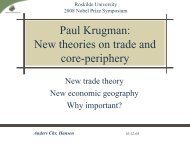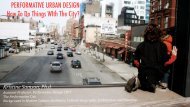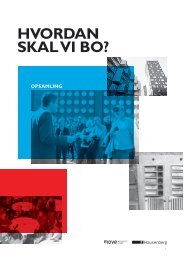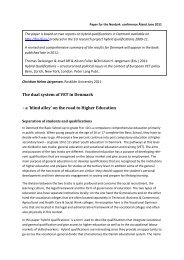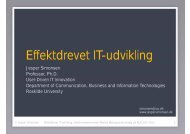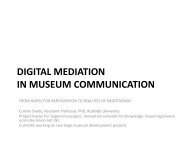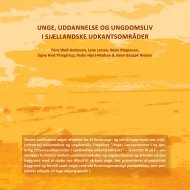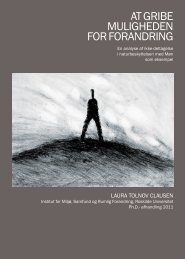Abstractbog printer - ansatte - Roskilde Universitet
Abstractbog printer - ansatte - Roskilde Universitet
Abstractbog printer - ansatte - Roskilde Universitet
You also want an ePaper? Increase the reach of your titles
YUMPU automatically turns print PDFs into web optimized ePapers that Google loves.
Abstracts - Posters<br />
P26. Nitrogen addition in semi-extensive aquaculture enclosures: effects<br />
on phytoplankton and zooplankton composition<br />
Blanda E. 1 , Bruno E. 2 , Jakobsen H. H. 3 , Jepsen P. M. 1 , Mahjoub M. S. 4 , Pedersen A. T. 5 , Rayner T.<br />
A. 1 & Hansen B. W. 1<br />
1 Department of Environmental, Social, and Spatial Change, <strong>Roskilde</strong> University, 4000 <strong>Roskilde</strong>,<br />
Denmark eblanda@ruc.dk, pmjepsen@ruc.dk, bhansen@ruc.dk<br />
2 DTU – Danmarks Tekniske <strong>Universitet</strong>, 2920 Charlottenlund, Denmark elebr@aqua.dtu.dk<br />
3 Department of Bioscience, Aarhus University, 4000 <strong>Roskilde</strong>, Denmark hhja@dmu.dk<br />
4 DHI-NTU Research and Education Hub, 128388 Singapore mma@dhi.com.sg<br />
5 Maximus A/S, 7755, Bedsted Thy, Denmark<br />
The aim of this project is to study the effect of inorganic nitrogen in a semi-extensive aquaculture<br />
system in northern Jutland, Denmark.<br />
We hypothesize that a higher availability of nutrients, in particular nitrogen in the form of NO3, will<br />
affect the food chain providing a higher availability of food for fish larvae. The final goal is in fact<br />
to increase the survival and development of the turbot larvae Scophthalmus maximus where the<br />
crucial factor is the appropriate diet.<br />
A manipulation experiment was performed in 280 m 3 open top tanks in late summer 2012 (middle<br />
august-early September). 2x3 tanks were spiked with inorganic Nitrogen (full- and pulse dose) and<br />
3 tanks were used as controls. The initial NO3 concentration of the full dose treatment was 15<br />
µmol/L while in the pulsed dose treatment the same amount was divided in 3 doses and added<br />
weekly during the campaign.<br />
Inorganic nutrients and phytoplankton concentration were analysed every third day, phytoplankton<br />
and zooplankton composition were monitored every week. Fatty acids (FA) of all trophic levels in<br />
the pelagic food web were analysed. This effort was established to set up budgets for energy and<br />
matter from phytoplankton to zooplankton to measure what is available in terms of copepod food<br />
and energy for fish larvae.<br />
The nutrient addition caused phytoplankton biomass to increase: chlorophyll a was less than 3,8 µg<br />
L -1 in the control enclosures, while it increased up to 50 µg L -1 in enclosures where nitrogen was<br />
added. As a consequence the abundance of zooplankton, in particular of copepods, increased<br />
significantly. Additionally the productivity and fecundity of the copepods in the full dose treatments<br />
was higher than the pulsed one or the control.<br />
In conclusion we can assume that inorganic nitrogen controls the productivity of the classical food<br />
chain and increase the phyto- and zooplankton biomass, along with the fecundity of the copepods.<br />
We suggest disposing of nutrient enriched green-water tanks to produce copepods for life feed in<br />
aquaculture and use the stock for feeding fish larvae to enhance the survival and development of<br />
turbot fry.<br />
Keywords: Nutrients; Phytoplankton; Zooplankton; Turbot larvae survival<br />
Program 17. danske havforskermøde, 143



